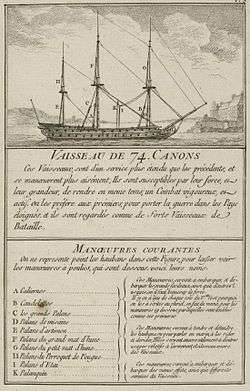French ship Palmier (1752)

The Palmier was a 74-gun ship of the line of the French Navy.
History
Built by Joseph Chapelle, her keel was laid down at Brest on 14 November 1750 as part of the shipbuilding boom between the end of the War of the Austrian Succession in 1748 and the start of the Seven Years' War in 1755.[1] She was built to the norms set for ships of the line by French shipbuilders in the 1740s to try to match the cost, armament and manouvrability of their British counterparts, since the Royal Navy had had a greater number of ships than the French since the end of the wars of Louis XIV.[2]
She was launched on 1 September 1752 and commanded by Joseph de Bauffremont during the Canadian campaign by Rémy-Claude de Bullion's fleet in May 1755 at the start of the Seven Years' War. She did not fight at Lagos or Quiberon Bay, in which the Toulon and Brest fleets were defeated in a new attempt at an invasion of Britain.
In 1778 the Palmier served as the vanguard at the Battle of Ushant, the first major Franco-British naval engagement of the American Revolutionary War. In 1780 she was sent to the Antilles as part of de Guichen's fleet. There she fought in the Battle of Martinique on 16 April and in two other indecisive encounters against Rodney's forces. In May 1781 she served as François-Aymar de Monteil's flagship in the Franco-Spanish attack on Pensacola in Florida. The Palmier then joined de Grasse's fleet, which had just arrived from France, and returned with it to the Antilles.
On 12 September 1781 she was in the midst of the battle of Chesapeake, a decisive French victory which let to the British defeat in the Siege of Yorktown. Still stationed in the Antilles, she took part in the Battle of St Kitts in January 1782. On 12 April she was part of the rearguard at the French defeat in the Battle of the Saintes. She was retired from the fleet the same year when it was ordered back to France, but was sunk by a major storm off the Bermudas on 24 October 1782.
References
- ↑ Patrick Villiers, La France sur mer : De Louis XIII à Napoléon Ier, Paris, Fayard, coll. « Pluriel », 2015, 286 p. (ISBN 978-2-8185-0437-6), page 126
- ↑ Martine Acerra and André Zysberg, L’essor des marines de guerre européennes : 1680-1790, Paris, éditions SEDES, coll. « Regards sur l'histoire », 1997, 298 p. (ISBN 2-7181-9515-0), pages 90-91
Bibliography
- Jean Meyer and Martine Acerra, Histoire de la marine française, Rennes, éditions Ouest-France, 1994
- Michel Vergé-Franceschi, Dictionnaire d'Histoire maritime, éditions Robert Laffont, coll. « Bouquins », 2002, 1508 p. (ISBN 2-221-08751-8)
- Jean-Michel Roche, Dictionnaire des bâtiments de la flotte de guerre française de Colbert à nos jours, volume 1, 1671-1870, éditions LTP, 2005, 530 p.
- Georges Lacour-Gayet, La Marine militaire de la France sous le règne de Louis XV, Honoré Champion éditeur, 1902, updated and republished 1910
- Georges Lacour-Gayet, La marine militaire de France sous le règne de Louis XVI Paris, éditions Honoré Champion, 1905